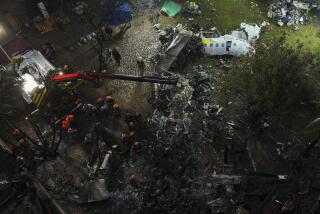Site of Sao Paulo Airport Next to Homes Is Debated
- Share via
SAO PAULO, Brazil — Residents of the Jabaquara neighborhood are used to man-made thunder.
Thanks to an unregulated construction boom, half a million people live in the district next to Sao Paulo’s busy Congonhas airport, occupying houses on what were once cow pastures when the airport was built five decades ago.
“The noise has always been part of our daily routine,” said Joao Cardoso. “We hardly noticed it at all.”
On the morning of Oct. 31, 1996, the routine shattered.
“The noise was too loud,” Cardoso recalled. “All of a sudden, I heard an explosion that shook the roof of my house.”
Barely 50 yards away, a Fokker-100 jetliner belonging to Brazil’s TAM Airlines was skidding down the street in a fireball. The crash killed all 96 people on board and three on the ground.
The disaster rekindled the debate over whether a major airport should be allowed to operate so near a densely populated area. And if not, where should it go?
Urban planners in Tegucigalpa, Honduras, Mexico City and other Latin American cities face similar dilemmas.
In April, a U.S. Air Force cargo plane overshot the runway at Toncontin, Tegucigalpa’s airport. It rolled 200 yards and burst into flames on a major boulevard. Three on board died. Miraculously, no one on the busy commercial street was injured.
The vice president of Honduras’ Congress, Oscar Armando Avila, said it was crucial to build the capital an airport farther out. But Transportation Minister Carlos Zelaya Appel said a new airport might cost $300 million, “and that amount is beyond the reach of the government.”
Sao Paulo is South America’s largest city, with a population of 16 million and an urban sprawl larger than Los Angeles. Over the years, “Sao Paulo embraced Congonhas,” said airport superintendent Jose Maria de Faria.
During those years, the airport grew too. Today, it is Brazil’s third busiest, handling about 460 flights and 15,000 passengers a day.
“Landing in or taking off from Congonhas is pure adrenaline,” said Luis Fernando Collares, who heads Brazil’s pilots union. “There is no room to maneuver if something goes wrong. There are no ‘emergency exits.’ ”
Lydia Veras Horta, leader of a neighborhood group lobbying officials to close Congonhas, said, “The planes fly so close to the buildings that some residents can see the faces of the pilot and co-pilot.”
The Aeronautics Ministry said there have been six accidents at Congonhas since 1990.
Nevertheless, moving the airport is unlikely. Collares figures a workable solution would be to “reduce the number of flights and the airport’s operating hours” and strictly regulate new buildings in the area.
More to Read
Sign up for Essential California
The most important California stories and recommendations in your inbox every morning.
You may occasionally receive promotional content from the Los Angeles Times.













